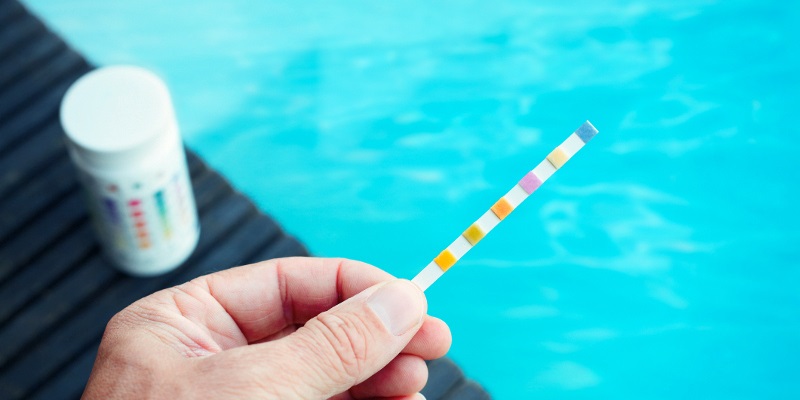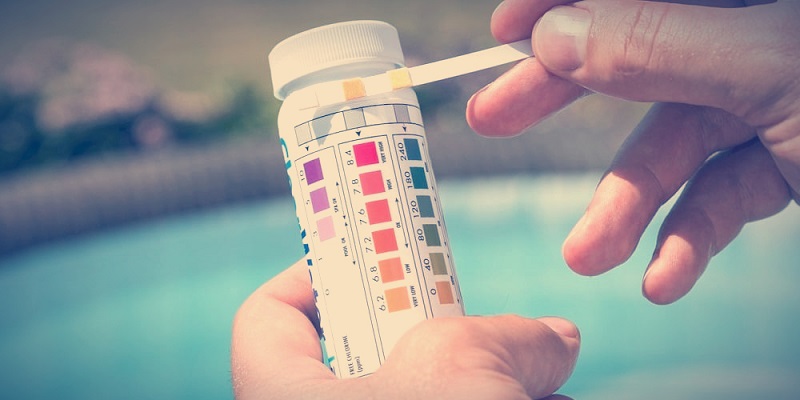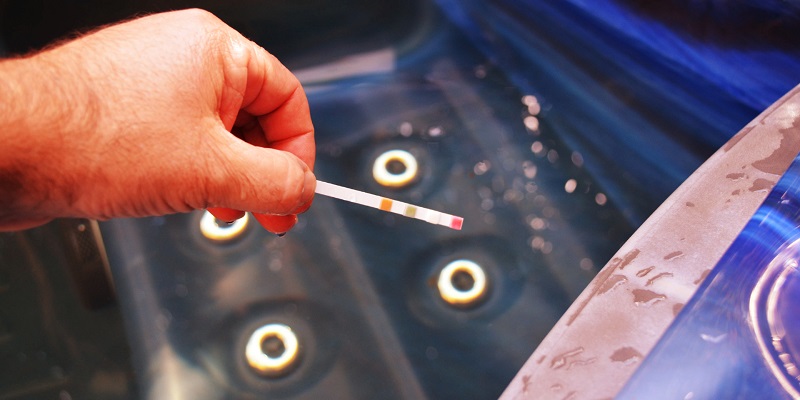Understanding hot tub test strips and how to read them can be quite daunting for the first few times. I show you just how simple it really is and what it all means.
Having the luxury of relaxing in your own hot tub with family and friends at home has become extremely popular over recent years. But, it is important to remember that when you create a warm and moist environment you are creating the perfect world for bacteria to grow.
By testing your hot tub water regularly you can ensure this doesn’t happen, keeping the hot tub safe for you and your family.
Read on to find how to test hot tub water with colour-coded test strips.
What Are Hot Tub Test Strips?
Contents

A hot tub test strip is a simple method for testing the water balance of your unit. It offers a quick reading of all key elements required in the spa water using a colour-coded system. Showing information such as the total alkalinity, pH level and calcium hardness of the water. Don’t worry I will go into more details a little later.
All you need to do is dip the test strip in the water and match the colours on the test strip to the colours on the sheet supplied with the test kit. Different brands might use different colours so it is important to always keep the packaging that the test kit comes with.
Although the health benefits of hot tubs are numerous, maintaining them is very important for health safety reasons. And, the importance of testing regularly cannot be understated. And, if there is a need for adding water treatments please remember you must re-check the values with a new test strip.
Testing Hot Tub Water: Why it’s Important

When you maintain well-balanced levels in your hot tub water you are not only ensuring it is hygienic but also making it friendlier to your skin.
Testing is also part of your general maintenance since certain levels of pH and hardness affect the hot tub materials. This can result in the longevity of your hot tub pump etc being reduced.
It doesn’t matter how careful you are, you will at some point find you have grit or sediment on the base. To remove this use a hot tub vacuum, they are easy to use and very affordable.
Hot Tub Test Strips How to Read Them

The information provided with your test kit will advise you about any levels that need to be corrected (and the chemicals required). I cover what each of the elements on the test strip is along with some additional information.
Total Hardness
Total hardness (or calcium hardness) can be the most destructive element for both you and your hot tub. If you start to see scale forming or your water is going cloudy it is likely this level that needs adjusting.
When there is too much calcium this may also cause your skin to feel dry and irritated, in the worst cases irritation in the eyes. Unfortunately, if you live in a hard water area there is no real way of reducing calcium levels with chemicals. You may have to use a softener for the water you use to fill the hot tub.
However, you can use a calcium booster to increase the level to the correct amount. Signs you have too little calcium are foam and a slimy feel on both the unit and your skin.
Total Chlorine
Chlorine is the element that keeps the water clean and prevents the growth of germs, bacteria and algae. Keeping any unwanted health risks under control. There is a choice of two sanitizing chemicals available. Either chlorine or bromine, they do the same job and the choice tends to be down to personal preference.
Total chlorine measures both free chlorine and combined chlorine but this chlorine test doesn’t make a distinction between the two.
Total chlorine levels should be between 1.5 & 3.0 PPM and between 3.0 & 5.0 PPM for bromine.
Free Chlorine
Free chlorine is the amount of chlorine that has yet to be combined with the water and working. Unlike the total chlorine reading that includes chlorine that is still in the water but has done its work.
Therefore, chlorine that is still active and able to remove any nasties is referred to as being free chlorine. This should also read between 1.0 and 3.0 but more than total chlorine.
pH Level
The pH level of a spa should be just above neutral, 7.2-7.6. The pH level lets you know how alkaline or acidic the water is.
To raise or lower the pH in a hot tub you will need to either use a pH increaser or pH decreaser. However, it is important to get the alkalinity level correct before trying to adjust the pH level.
Total Alkalinity
Total alkalinity readings are between 0-360 with the ideal range between 80-120. How to raise or how to lower alkalinity in a hot tub is the same as pH level, add a spa alkalinity adjuster.
Since the alkalinity influences the pH stability, it is important to check both values. High or low alkalinity in a hot tub should be addressed first because sometimes this is already enough to get to the right pH level.
People Also Ask (FAQs)

If you are new to the world of hot tub testing and still getting used to reading spa test strips. Then perhaps some of the following commonly asked questions will help you better understand the different methods available.
How do I know if my hot tub water is safe?
Using water test strips is the quickest and easiest method to check that your hot tub water is safe. These test kits include a description of what the values mean and what the safe ranges are for each component.
What is the most accurate way to test pool water?
To achieve the most accurate reading when testing pool water I would recommend a digital pool water tester. Many are designed to be left in the pool or hot tub allowing you to spot any imbalance in the levels immediately.
Are pool water test strips accurate?
Using pool water test strips tends to be more accurate than pool water test kits. They are also an affordable and simple way to test your water.
Conclusion
Test strips are one of the most affordable and simple ways for how to test spa water. You are able to read what levels you have in seconds and decide on any chemicals they may need topping up.
Always keep the instruction manual so that you know what the values mean. Since there are many different brands, the colour coding may be different.